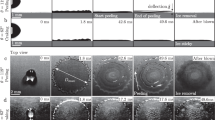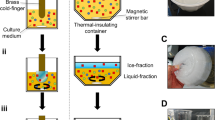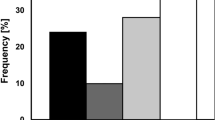Abstract
Insects that are cold-hardy but sensitive to freezing survive at low temperatures due to their capacity for supercooling—their supercooling points are below −25 °C. In addition to polyols, these insects produce proteinaceous thermal hysteresis antifreeze agents reported to prevent growth of ice crystals down to ∼−10 °C, thus stabilizing the supercooled insects down to this temperature1,2. We report here that in the beetle Rhagium inquisitor the ability of thermal hysteresis agents to prevent growth of ice crystals increases substantially when the crystal size is diminished. Thus, supercooled insects may be protected against growth of embryo ice crystals over their whole supercooling range, that is, they may be protected against freezing even during prolonged exposures to temperatures as low as −30 °C. The present observations are in accord with the prevalent theories for the action of antifreeze agents.
This is a preview of subscription content, access via your institution
Access options
Subscribe to this journal
Receive 51 print issues and online access
$199.00 per year
only $3.90 per issue
Buy this article
- Purchase on Springer Link
- Instant access to full article PDF
Prices may be subject to local taxes which are calculated during checkout
Similar content being viewed by others
References
Duman, J. G. J. Insect Physiol. 25, 805–810 (1979).
Husby, J. A. & Zachariassen, K. E. Experientia 36, 963–964 (1980).
DeVries, A. L. Science 172, 1152–1155 (1971).
DeVries, A. L., Komatsu, S. K. & Feeney, R. E. J. biol. Chem. 245, 2901–2908 (1970).
Theede, H., Schneppenheim, R. & Beress, L. Mar. Biol. 36, 183–186 (1976).
Zachariassen, K. E. J. comp. Physiol. 140, 227–234 (1980).
Chalmers, B. Scient. Am. 200 (2) 114–122 (1959).
Baust, J. G. & Zachariassen, K. E. Cryo. Lett. (submitted).
Zachariassen, K. E. & Hammel, H. T. Nature 262, 285–287 (1976).
Sømme, L. & Conradi–Larsen, E. M. Oikos 29, 118–126 (1977).
Raymond, J. A. & DeVries, A. L. Proc. natn. Acad. Sci. U.S.A. 74, 2589–2693 (1977).
DeVries, A. L. in Animals and Environmental Fitness (ed. Gilles, R.) 583–607 (Pergamon, Oxford and New York, 1980).
Author information
Authors and Affiliations
Rights and permissions
About this article
Cite this article
Zachariassen, K., Husby, J. Antifreeze effect of thermal hysteresis agents protects highly supercooled insects. Nature 298, 865–867 (1982). https://doi.org/10.1038/298865a0
Received:
Accepted:
Issue Date:
DOI: https://doi.org/10.1038/298865a0
This article is cited by
-
Urea and plasma ice-nucleating proteins promoted the modest freeze tolerance in Pleske’s high altitude frog Nanorana pleskei
Journal of Comparative Physiology B (2018)
-
Purification and Identification of Antifreeze Protein From Cold-Acclimated Oat (Avena sativa L.) and the Cryoprotective Activities in Ice Cream
Food and Bioprocess Technology (2016)
-
Extraction of Oat (Avena sativa L.) Antifreeze Proteins and Evaluation of Their Effects on Frozen Dough and Steamed Bread
Food and Bioprocess Technology (2015)
Comments
By submitting a comment you agree to abide by our Terms and Community Guidelines. If you find something abusive or that does not comply with our terms or guidelines please flag it as inappropriate.



